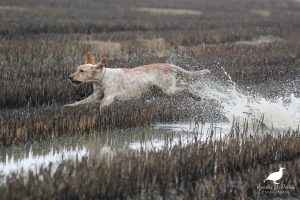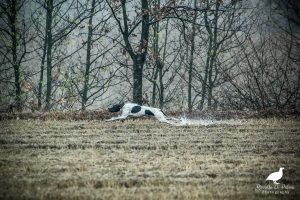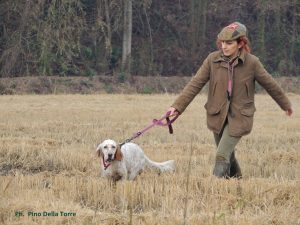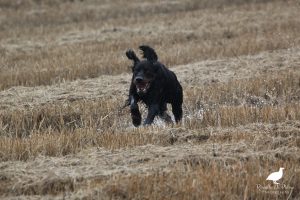Altre brevi note sul setter nero focato – di Rino Radice
Altre brevi note sul setter nero focato – di Rino Radice Rassegna Cinofila Novembre-Dicembre 1936 XV
Trascrizione a cura di Maurizio Peri
I Brevi appunti sul setter nero focato da noi pubblicati nell’ultimo numero di questa Rassegna, non hanno incontrato il favore di un anonimo scrittore di “La Caccia e la Pesca” (v. La Caccia e la Pesca, n.3: A proposito del Setter scozzese – sinonimi: Setter Gordon, Setter nero fuocato – smentite ufficiali che non smentiscono ma confermano) e del Prof. Gino Pollacci (v. Diana 1936, n. 24: Ancora sul Setter Scozzese).
Il dissenso non ci stupisce affatto perché è da tempo che La Caccia e la Pesca va ospitando articoli nei quali si sostiene sia la denominazione di scozzese sia il mantello tricolore per la razza di cui è questione, ed il Prof. Gino Pollacci nel n. 19 (15 Ottobre) di Diana 1936 spezzava ancora, posteriormente dunque al riconoscimento E.N.C.I. alla Società del Setter nero fuocato, una lancia a favore del mantello tricolore e della denominazione… scozzese.
E’ appunto a causa di tali pubblicazioni che abbiamo ritenuto opportuno e doveroso pubblicare i nostri brevi appunti. Il dissenso dunque non ci stupisce perché già conosciuto, ma quello che ci stupisce è il modo col quale specialmente l’anonimo scrittore de La Caccia e la Pesca, ed, in tono minore, il Prof. Pollacci, hanno creduto di potere demolire le conclusioni cui eravamo arrivati nei nostri brevi appunti.
Avevamo onestamente pubblicato integralmente cinque documenti (le lettere dei Sigg. Eadington, Jack e Wright, la memoria del Sig. Bolam e lo standard ufficiale inglese), ne avevamo tratte le nostre conclusioni, sulle quali il lettore poteva pur dissentire, ma avevamo dato mezzo al lettore di formare il suo giudizio alle medesime fonti dove avevamo attinto il nostro; non ci aspettavamo però che per giungere a diverse conclusioni si potesse osare di citare incompletamente e di stroncare i pensieri degli autori dei documenti pubblicati.
Questo stroncamento è la causa principale del nostro stupore.
L’anonimo scrittore di La Caccia e la Pesca scrive:
“E’ bene ricordare come sia venuto alla luce il nome di Setter Scozzese, recentemente bocciato. Non è stato un capriccio nostro. No. Esso è stato preso da una pubblicazione ufficiale dell’E.N.C.I. sul Setter Gordon (nero focato), apparsa nei numeri 3, 4, 5, 6, 7, e 8 di Rassegna Cinofila del 1931, appunto con il nome di Setter Scozzese, Questa pubblicazione dovuta al Prof. Gino Pollacci era avallata, senza alcuna riserva, dalla firma del Dr. Rino Radice, Segretaraio Generale dell’E.N.C.I., quale Direttore della Rivista. La pubblicazione portava bene in vista questo titolo Setter Scozzese (sinonimi: Setter Gordon, Setter nero fuocato) e di essa furono editati anche e distribuiti degli estratti, ad evidente scopo di indirizzo cinofilo. L’A. Prof. Gino Pollacci, dimostrava in essa che l’origine del Gordon era la Scozia e l’E.N.C.I. teneva a battesimo nel 1931 questa asserzione, e, come già abbiamo detto, le dava il crisma ufficiale.

Nessuno allora protestava, nemmeno i lettori de Il Cacciatore Italiano.
Quest’anno in un primo tempo all’epoca del riconoscimento della Società Italiana, non teneva più conto del nome stabilito sotto i suoi auspici, metteva da una parte la pubblicazione ufficiale, e non voleva più saperne del nome Scozzese ed indirettamente della riconosciuta provenienza”
E’ vero che il Prof. Pollacci nel 1931 faceva pubblicare, nei N. 3, 4, 5, 6, 7, e 8 di Rassegna Cinofila, uno studio sul setter nero fuocato, studio che conteneva anche una traduzione dello standard stabilito dalle società scandinave ed una traduzione dello standard stabilito dalle società britanniche ed infine chiudeva, dopo avere affermato essere preferibile quest’ultimo in confronto del primo, con una proposta di standard che senza avere la pretesa di volerne stabilire uno diverso da quello scozzese, può completarlo e renderlo meno improprio nella dicitura se non modificarlo (v. Rassegna Cinofila, 1931, N.8, pag. 319).
E’ vero che il Prof. Gino Pollacci, secondo la consuetudine, faceva riunire in un opuscolo le sei puntate del suo studio apportandovi anche qualche variante e l’opuscolo diffondeva fra gli amici. Ma le proposte del Prof. Pollacci non avevano più seguito; l’E.N.C.I. non ha mai fatto sue né la proposta di mutamento del nome né la proposta di standard. Non sappiamo a quale canone, a quale consuetudine giornalistica l’anonimo possa appellarsi per giustificare la pretesa peregrina che la pubblicazione di un articolo firmato nella parte redazionale di una rivista, sia pure ufficiale di un Ente, porti con sé automaticamente che le conclusioni cui l’articolista è giunto diventino per sé stesse ufficiali e che la firma del Direttore, concessa come affermazione di responsabilità verso lo Stato, avalli le conclusioni, magari anche le sublimità o le castronerie, cui l’articolista può avere dato corpo.
La pubblicazione dello studio sul setter n.f. compiuto dal Prof Pollacci non aveva allora carattere ufficiale, come non lo hanno i nostri brevi appunti e queste nostre note aggiunte. Si tranquillizzi adunque l’anonimo scrittore de La Caccia e la Pesca; l’E.N.C.I. non ha mangiato –novello Saturno – i suoi figli sia perché il gesto non è mai stato né morale né estetico, sia perché, in questo caso, figli non aveva avuto né ha.
All’anonimo scrittore ed, in tono minore, al Prof. Pollacci invece domandiamo quale giudizio essi farebbero di un contradditore che, per coglierli in fallo, si permettesse di citare incompletamente i loro scritti. Domandiamo perciò a loro ed al lettore imparziale se sia giornalisticamente corretto e polemisticamente efficace affermare:
che il Signor Bolam -la cui memoria tradotta non è che il cenno illustrativo premesso alla nuova edizione dello standard (il quale ora non porta più la scala dei punti) (1) quindi qualcosa di ben più importante di quello che non possa esserlo l’espressione del pensiero personale di un noto od ignoto cinofilo, e con ciò intendiamo rispondere al Prof. Pollacci che taccia d’incompetente il Bolam stesso – scrive che l’origine del Gordon è praticamente sconosciuta, ed ammette che nel 1830 il Duca di Gordon aveva un gran numero di setters di colori vari ma sottacere la conclusione cui il Bolam giunge, dopo avere dissertato alquanto sui cani appartenenti al Duca di Gordon sugli incroci a questo o ad altri attribuiti e sulla mancanza di ogni prova in merito e, cioè che : ANZI NON POSSIAMO NEANCHE AFFERMARE CON SICUREZZA CHE IL SETTER GORDON PROVENGA DAL CASTELLO DI GORDON.
che il Sig. Jack scrive che la razza si chiama Gordon dal nome del Duca di Gordon che risiedeva nel castello scozzese ecc ed omettere il seguito: LA VERA ORIGINE DELLA RAZZA E’ SCONOSCIUTA ma comunque essa non esisteva nel 1803. Il Colonnello Thornton, noto sportivo di quel periodo ebbe occasione di visitare il Castello di Gordon e nel suo libro: “Northern Tour” scrive di un incrocio che il Duca aveva fatto fra un lupo ed un volpino di Pomerania (2);
che il Sig. Whright afferma che in origine il Setter Gordon fu allevato dal Duca di Gordon ecc. e tralasciare che vi sono molte teorie sull’origine della razza e che il vero, è probabilmente che questi cani, che erano neri, bianchi e focati, erano della STESSA RAZZA DEI SETTERS INGLESI, che in altre parole c’erano tre tipi di setters inglesi cioè “Laverack”,”Belton” e “Gordon” e che più tardi questi Gordon furono conosciuti sotto il nome di setters “nero fuocati”.
L’anonimo autore de La Caccia e la Pesca ci fa poi rimprovero di non aver fatto nulla di nuovo col riportare lo Standard britannico del setter nero fuocato salvo la pessima traduzione, mentre esso standard si trova assai ben tradotto “ letteralmente” nella pubblicazione così detta ufficiale del Prof. Pollacci (v. Rassegna 1931). Saremmo pronti a batterci il petto se ci sentissimo traditori dello standard britannico; ma noi non abbiamo fatto quella traduzione perché ignari della lingua inglese; fidenti però nella piena esperimentata conoscenza delle lingue italiana ed inglese sia da parte della Signora Americana cui era stata affidata la traduzione, sia da parte dell’allevatrice cinofila italiana che parlando perfettamente la lingua inglese apportò la propria competenza tecnica nella revisione dell’opera della prima, siamo in dovere di difendere il lavoro delle nostre benemerite collaboratrici. Potremmo citare una rispettabile serie di imprecisioni della traduzione del 1931; ci limitiamo a scegliere nel mazzo alcuni punti riportando per il raffronto il testo inglese e le due traduzioni 1931 e 1936:
| Testo inglese | Trad. 1931 | Trad. 1936 |
|
A stylish dog, not so racy as the Irish, but more dignified in appearance,
Clear colours
The head should have a clearly indicated stop
On the inside of the hind legs and inside of thighs showing down the front of the stifle and broadening out to the outside of the hind legs from the hock to the toes. It must, however, not completely eliminate the black on the back of hind legs.
The bloodhound type with heavy and big head and ears and clumsy body, as well as the collie type with its pointed muzzle and curved tail. |
APPARENZA GENERALE
Cane che ha uno stile proprio non tanto bello quanto l’irlandese ma più massiccio per l’aspetto….
Colore spiccato TESTA La testa deve avere un portamento nettamente definito MACCHIE Sul lato interno delle zampe posteriori, in basso anteriormente sui ginocchi fino al lato esterno delle zampe posteriori, dall’anca fino alle dita. Non è detto che debba mancare completamente il nero sui lati delle zampe posteriori. DIFETTI- IMPRESSIONE GENERALE Il tipo del cane consanguineo con testa ed orecchi pesanti e larghi, corpo tozzo come il tipo collie con il suo muso appuntito, la coda curva |
Un cane di stile, di aspetto meno snello del setter irlandese ma di apparenza più dignitosa
Colori ben definiti
Lo stop della testa è ben marcato
Sulle parti interne degli arti posteriori e delle coscie, le macchie possono allargarsi fino alla parte esterna degli arti fra il garretto ed il piede, ma non devono però eliminare completamente il nero sul retro degli arti posteriori.
Tipo Bloodhound con testa grossa e pesante, orecchie troppo grandi e corpo senza garbo; anche il tipo Pastore scozzese, con il muso a punta e la corda arcata |
Tanto l’anonimo scrittore de La Caccia e la Pesca come il Prof. Pollacci fanno dell’ironia per avere noi concluso che il Setter nero fuocato ha avuto le sue origini nelle isole britanniche. La conclusione è esatta e doverosa: forse che al pointer non è stata attribuita erroneamente la derivazione dal bracco italiano, e con qualche maggiore probabilità, dal bracco spagnolo?
E con ciò non ci occuperemo più dell’anonimo di La Caccia e la Pesca, ma passeremo a dare alcuni schiarimenti al Prof. Pollacci incominciando dal rimprovero rivoltoci in tema di standard (3) di avere tradotto con testa con molto spazio per il cervello (!) la frase: with plenty of brain room che egli ora dice volere significare cassa cranica grossa. Prescindendo che la traduzione letterale della frase inglese è: con abbondanza di cervello spazio, non ci pare inutile rimandare il Prof. Pollacci alla sua stessa traduzione del 1931 ed alla sua stessa proposta di standard ch’egli allora aveva fatta; si legge testualmente nell’una e nell’altra: con abbondante scatola cerebrale! Il che può essere zuppa e pan molle con la nostra testa con molto spazio per il cervello (che si riferisce alla capienza della scatola) e non già con cassa cranica grossa (che si riferisce alla grossezza delle pareti).
Il Prof. Pollacci poi ci rimprovera di avere accennato alla possibile immissione di sangue Bloodhound negli ascendenti del setter nero fuocato nonostante che il Bolam lo escluda o meglio ne infirmi la prova data da taluni col richiamo al rosso nell’occhio. E’ vero che il Bolam non fa caso di tale prova. Ma il Prof. Pollacci non cita, neppure per demolirlo, il periodo della lettera del Sig. Jack in cui è detto: “ Si trovano pure delle referenze a tipi più pesanti, con la testa grossa e pesante, con le labbra grosse e pendenti, MOSTRANDO UN RECENTE INCROCIO CON IL BLOODHOUND ed il setter inglese o l’irlandese”.
A tale proposito ricordo che lo standard proscrive tanto il tipo Bloodhound, come il tipo collie, segno evidente che immissioni di tali sangui sono avvenute ed ora se ne vorrebbero eliminare le conseguenze. E il Prof. Pollacci ben sa che sono stati importati in Italia soggetti dove la impronta del Bloodhound è indiscutibile! Così per l’intervento del collie, non abbiamo da osservare che il Prof. Pollacci insiste ancora sulla leggenda del cane da pastore scozzese usato dal Duca di Gordon per la formazione della razza, mentre il Bolam non vi crede e tutti gli altri informatori non ne parlano.
Ancora: il Prof. Pollacci vuol persuadere che altri, oltre lui, ha usato per il setter n.f. il nome di scozzese e che altri, oltre lui, ha combattuto per il mantello tricolore nel setter nero fuocato. Gliene diamo atto ma osserviamo:
per il nome: che il tentativo non ha trovato successo né nelle isole Britanniche né in Scandinavia né nell’Europa continentale;
per il mantello: che nessuno ha mai negato che in origine esso fosse tricolore, ma è indiscutibilmente esatto che ora il bianco non è desiderato (“la macchia sul petto più piccola è, meglio è”); la lettera di Paul Caillard riportata integralmente dal Prof. Pollacci non fa che documentare la sconfitta subita nel tempo dalla tesi sostenutavi cinquantacinque anni fa dal competentissimo e valentissimo giudice francese. A confutare poi l’ultima affermazione del Caillard e del Signor Trewithick che una gran parte dei cani iscritti allo Stud Book del Setter, cani nero e fuoco non hanno alcun rapporto con la primitiva razza dei Duchi di Gordon, dovrebbe pur servire il seguente brano della lettera inviataci dal Sig. Wright, Segretario del British Gordon Setter Club:
Una signora entusiasta, la Signora R.M. Gray, ha dedicato molto tempo di quest’anno allo studio di antichi libri di origine e giornali cinofili ed asserisce, escludendo ogni dubbio, che tutti i Gordon moderni discendono da “Jobling’s Dandye”
Quel Jobling’s Dandye, discendente dalla razza di Gordon che vinse il primo premio per tutti i Setters alla esposizione di Newcastle nel 1859!
Ed a proposito di gordons tricolori il Prof. Pollacci non è a cognizione che ad una femmina importata in Italia sia stata fatta scomparire la macchietta bianca che aveva sul petto? Perché? Il bianco non è forse desiderato?
Il Prof. Pollacci infine ci accusa di avere riprodotto, quale prototipo del Setter nero fuocato, l’effige di un Setter tolto dalla sua monografia; quella monografia che, secondo lui, noi non avremmo mai letto! Tale disegno, egli dice, non riprodurrebbe un setter n.f. puro ma bensì il lontano discendente di un incrocio fra un puro ed un irlandese. Questo sa il Prof. Pollacci perché ne fu informato dal norvegese Prof. Helgeby di Oslo su testimonianza del norvegese Schilbred.
L’informazione può essere esatta, ma l’accusa fattaci non ci tocca; non abbiamo usato per la illustrazione la figura data dal Prof. Pollacci or sono cinque anni; ma abbiamo direttamente riprodotto la figura come intestazione della carta da lettera del British Gordon Setter Club, di cui, vedi combinazione, è proprio presidente onorario il Duca di Richmond e Gordon! La cantonata dunque, se vera, non è nostra!
A chiusura non ci resta dunque che concludere, con sopportazione dei contradditori, che manteniamo perfettamente integre, con più vigorosa persuasione se fosse possibile, le quattro conclusioni cui eravamo arrivati nei precedenti nostri brevi appunti.
RINO RADICE
(1) se la scala dei punti avesse fatto parte, anche in una sola edizione delle due che abbiamo ricevute, dello standard britannico, non l’avremmo certo omessa, anche se la scala in genere non gode delle nostre simpatie, e non siamo soli in tale apprezzamento negativo (N.d.A.).
(2) la citazione di questo incrocio non è fatta per attribuire all’ascendenza del Setter Gordon il lupo ed il volpino, ma unicamente per dimostrare che il noto sportivo Thornton recatosi a Gordon nel 1803 non vi trovò ancora i Setter Gordon ma, sola cosa rimarchevole, l’incrocio citato.
(3) cogliamo l’occasione per correggere due errori in cui il proto è caduto nel riportare la nostra traduzione dello standard: parlando della testa egli ha fatto diventare asciugato ciò che era asciutto nell’originale ed ha ridotto un naso grande in un non grande. Anche il Prof. Pollacci sa che tali infortuni sono tipograficamente sempre possibili, cosicché nel suo attuale articolo di Diana il nome del Signor Bolam e ripetutamente e costantemente divenuto Bloam.



